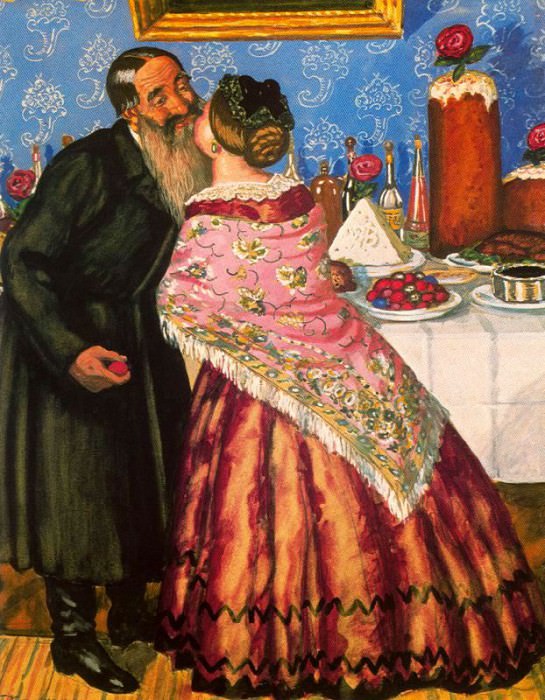#43774 Boris Kustodiev (1878-1927)
Boris Kustodiev – #43774
Edit attribution
Download full size: 622×800 px (0,1 Mb)
Painter: Boris Kustodiev
Kustodiev, who was able to combine classical traditions with the national ideal of folk art in his work, did not refuse innovations created by modernism and impressionism either. The canvas is filled with bright contrasts of light and refinement of decorative stylization of external form. The artist seems to express his admiration for the vanishing fair and merchant culture of the people. The theme of folk festivals is reflected in many works of the author. The painting depicts the folk-church tradition of kissing during the greeting of the feast of Easter.
Description of Boris Kustodiev’s painting "Easter Rite" (1916)
Kustodiev, who was able to combine classical traditions with the national ideal of folk art in his work, did not refuse innovations created by modernism and impressionism either. The canvas is filled with bright contrasts of light and refinement of decorative stylization of external form. The artist seems to express his admiration for the vanishing fair and merchant culture of the people. The theme of folk festivals is reflected in many works of the author.
The painting depicts the folk-church tradition of kissing during the greeting of the feast of Easter. The action of the scene takes place in a merchant’s house. A young girl is kissing a man who is old enough to be her father. He takes pleasure in this: the look on his face is heartwarming. The audience can’t see her face, but they can see her embarrassment, which the artist underlines with pinkish skin.
Details that the painter has a special attitude towards are painted thoroughly. The merchant is dressed in a long black caftan and wears shiny and polished boots. His hair with a straight parting and his beard also testify to his social status. The girl is dressed for the occasion in a sumptuous red silk dress trimmed with black lace, which has a white lace collar. Accurately arranged in a hairstyle blond hair on her head is covered by a coquettish hat. Complementing the outfit of a young lady thrown over her shoulders painted bright shawl with fringes in pink and greenish-yellow tones.
The man has already prepared a gift for Easter - a dyed egg, which he holds in his hand. The table is laid out in a festive way: on it there are all the traditional Easter dishes. Two kulich, decorated with flowers, and the consecrated custom of Easter curds. Nearby is a large dish with a whole heap of painted eggs in different colors. A roast pig and a waa with black caviar speak of prosperity in the house. Next to the wall with the patterned blue wallpaper and the painting hanging above, a whole battery of homemade liquors is lined up on the table. All the objects are painted with naturalistic precision.
The picture of the monumental festive folk ritual combines lubonic traditions with the highest museum classics. The viewer is captivated by the provincial atmosphere of folk rites and rituals.
Кому понравилось
Пожалуйста, подождите
На эту операцию может потребоваться несколько секунд.
Информация появится в новом окне,
если открытие новых окон не запрещено в настройках вашего браузера.
You need to login
Для работы с коллекциями – пожалуйста, войдите в аккаунт (open in new window).




















COMMENTS: 2 Ответы
* * *
Пышный, как московские хлеба
Мир Кустодиева – сдобный.
Сытая купецкая судьба.
Чаепитья стол весьма подробный.
Сок и смак, и райские цветы.
И Шаляпин в дорогущей шубе.
Небо в облаках – у высоты
Знание своё – что значат судьбы.
КУПЕЧЕСТВО
1
Брадат, боголюбив,
В молельне три часа,
Не видит перспектив
Иначе – данность вся
Обман! Таков купец,
Усерден, твердолоб,
Поживший молодец,
Попивший.
Лёгший в гроб
2
У Печерского дремучий морок
Данных густотой самой лесов.
Водит леший, будь кому за сорок,
Иль под шестьдесят. Лешак суров.
А земное масло созревает –
Взять его потянешь ли, купец?
Баржи, скарбом полные, гоняет,
Проплывает берегами лес.
Дом большой, весьма надёжны ставни,
А в молельне мерно данный свет.
Свет свечей, лампад, всё это славно.
Смысла жизни почему-то нет.
Тороват…Быть сильным, тороватым,
До конца себя едва ль узнать.
Под конец – неважно быть богатым
Резко, с чернотою осознать.
3
Купечество – как род жречества,
Деньги – алтарь в храме купечества.
4
Взгляд с прищуром, и волосы намаслены,
И объегорил, хват, поставщика.
Коль выгоды плоды предстанут ясными,
Валять не стоит дурака.
Нагружены разнообразно баржи,
И пенится вокруг вода.
Купец – он знает нужды ваши,
При этом с барышом почти всегда.
5
В глухом углу…весь город от оврага
Вверх лезет, с мезонинами дома –
Миллионер и мукомол, весьма
Тяжёлый нравом…
В церкви старой рака –
И бьёт поклоны пивший тридцать дней.
В торговле крут, ворочает делами,
Срывается потом, сорит деньгами,
Живёт, лихой, заложником страстей.
6
Круто вёл дела, седел, матерел,
В купеческом клубе, напившись, пел,
Закусывал исключительно капустой квашеной,
Судьбой он полагал уваженный.
К торговому добавлял пассажирское пароходство,
И всё больше пил, всё больше в скотство
Погружался, седел, матерел,
Задумывался, тяжело от мыслей шалел.
Жертвовал монастырю, молился там.
И давило сердце.
А деньги – к деньгам.
7
Пыльно несколько в конторе,
Строг отец, а сын забит.
Чей там голос в коридоре?
Входит некто, деловит.
Сын, разинув рот внимает
Разговору, вялый сын.
Муху пёрышком толкает.
Осень. Вот сказать бы – сплин,
Да купцу не по карману
Роскошь эта. Серый свет
За окном сродни туману.
Резковат купца ответ.
You cannot comment Why?
Perhaps it’s a painting of a man and a woman standing next to each other in front of a table with a cake and a painting on the wall behind them.